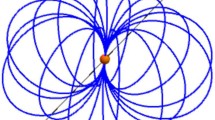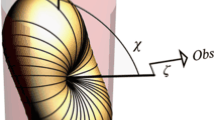Abstract
It is shown that the low frequency radiation emitted by a magnetic neutron star with the axis of its dipole field at an angle to the rotation axis, is periodic. This low frequency radiation accelerates electrons and protons to high energies. The synchrotron radiation emitted by the high energy particles in the ambient magnetic field is shown to be the pulsar radiation.
Similar content being viewed by others
References
Gold, T...Nature, 1969,221, 25.
Komesaroff, M. M...Ibid., 1970,225, 612.
Deutsch, A...Annales d’Astrophysique, 1955,18, 1.
Gunn, J. E. and Ostriker, J. P.Phys. Rev. Lett., 1969,14, 728.
Bradt, S., Rappaport, S., Mayer, W., Nather, R. E., Warner, B., Macfarlane, M. and Kristian, J.Nature, 1969,222, 728.
Author information
Authors and Affiliations
Additional information
Communicated by Prof. R. R. Daniel,f.a.sc.
Rights and permissions
About this article
Cite this article
Apparao, K.M.V. A mechanism for pulsar radiation. Proc. Indian Acad. Sci. 73, 1–6 (1971). https://doi.org/10.1007/BF03047330
Received:
Issue Date:
DOI: https://doi.org/10.1007/BF03047330




